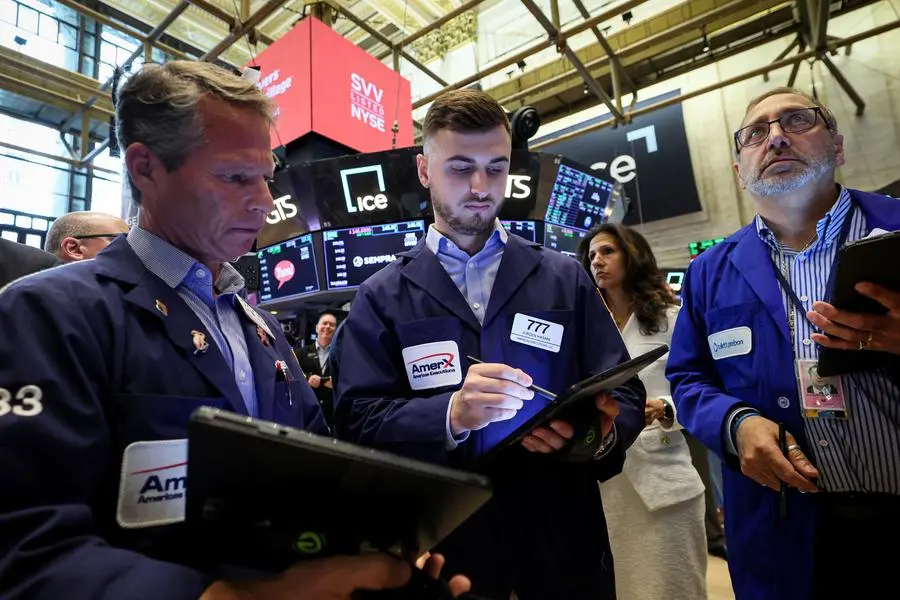PHOTO
LONDON - Dismissal of this year's much-scorned equity market rally as the frothy preserve of a handful of AI-fuelled stocks may be both misleading and also one of its strengths.
Despite a 16% rise in the most-tracked S&P500 index of leading stocks and the best first half for the tech-heavy Nasdaq in 40 years, a recession-wary, bond-loaded investment world has repeatedly batted away 2023's stock market rebound as too narrow, top-heavy and unsustainable.
The central charge is that an equal-weight version of the S&P500 - a proxy for the average stock that assigns equal weight to each one regardless of company size - has only gained about 6%. Or, put another way, if you remove the top 10 stocks, the other 490 would only have gained 4%.
And an eye-popping 75% surge in the high-octane 10-stock FANG+TM index - mega cap U.S. digital and tech stocks including Apple, Microsoft, Nvidia and Tesla - underlines that.
Yet this is not some obscure corner of the equity universe. These are of the biggest stocks on the planet - with Apple the first company to ever clock a $3 trillion market cap last week.
They sit in most mixed portfolios and variously wend their way into tech, growth, quality, defensive and even sustainability-themed investment buckets. In short, they're hard to avoid unless you dodge either U.S.-listed companies or equity markets altogether.
And the estimated $7.1 trillion of indexed assets directly tracking the most-benchmarked index in the world might not care hugely how that 16% gain arrived.
Although gains for the small-cap Russell 2000 have been more modest at 7.7%, exposure to the widest measure of the publicly-listed U.S. stock universe - the Wilshere 5000 - would also have bagged you a return of 16%.
But even if you assume the relative narrowness of the U.S. stock rally questions its sustainabilty, is flattered by ChatGPT-type hype or even somehow presages a quick reversal - the global view paints a different story.
Societe Generale's Andrew Lapthorne points out that not only has the MSCI all-country index jumped 13% since January, but equal-weight MSCI Europe, Japan and U.S. indices have seen the best start to the year since 1998.
"While the U.S. obsesses about performance being concentrated in just a few stocks, the overall rally is actually quite broad," he wrote, adding that the AI-spin was not the only game in town and combined with numerous other investment themes.
NARROW MINDED?
While the AI theme seems to have electrified growth stocks in the United States, it is cheap, beaten 'value stocks' in Europe and Japan that have driven outsize performance - with defence, 'geo-economics' and even currency playing differing roles.
Japan's Nikkei has hit its highest in 33 years after its best start to the year since 1999, with gains of almost 30%. Germany's DAX has added 15% and hit a record high in June. Italy's financials-heavy FTSE MIB has climbed almost 20% to its highest in 15 years.
And while many put down U.S. excitement around artificial intelligence to hype or a mini bubble, there are others who think the leap in so-called generative AI will start to fan out beyond the leading lights and chip infrastructure stocks now benefitting most and infuse other sectors.
Consultants McKinsey reckon generative AI will have a significant impact in all sectors, with banking, high tech and life sciences to the fore.
Across the banking industry, it estimated the technology could deliver value equal to an additional $200-$340 billion annually if the use cases were fully implemented. In retail and consumer packaged goods, it saw a potential impact as high as $400-$660 billion a year.
And yet despite all the first quarter heat and optimism, global investors remain hugely biased towards bonds and underweight equities.
And this persistent skew in positioning may be one of the best arguments for broadening the equity advance over the remainder of the year - assuming some other shock or an unexpected economic nosedive doesn't in fact materialise.
As Bank of America's survey of global fund managers showed in June, investors were their most overweight in bonds in eight years, held a net underweight position in world equities that's more than two standard deviations below historical averages, and see Big Tech stocks as the most crowded trade.
New shocks aside, there appears to be plenty of scope for further rebalancing just to get back to more normal holdings.
The big challenge for many savers and investors will be whether to forgo pumped-up cash returns of circa 5% - which have more than doubled over the past year.
But as Schroders strategist Duncan Lamont points out, that only makes sense for investors with relatively short horizons.
Over the past 96 years, Lamont showed that returns on U.S. large cap stocks have beaten inflation more often than cash over any time horizons from one to 20 years. For every 20-year timeframe, equities delivered inflation-beating returns - but cash only managed to do that two thirds of the time.
"While stock market investments may be risky in the short run, when viewed against inflation they have offered far more certainty in the long run," he told clients.
The opinions expressed here are those of the author, a columnist for Reuters
(by Mike Dolan, Twitter: @reutersMikeD Editing by Mark Potter)























